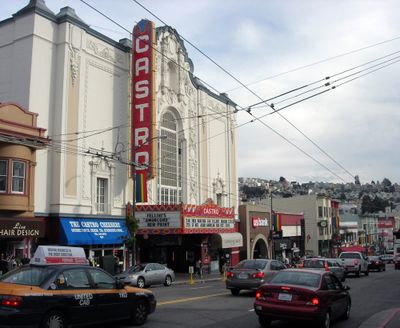Following the footsteps of Harvey Milk
San Francisco’s Castro district comes alive in audio tour

SAN FRANCISCO – There’s a new kind of tourist in San Francisco’s Castro district, the neighborhood that’s billed as the gayest in the world.
With serious looks on their faces, the tourists walk along flamboyant Castro Street, past the rainbow-colored gay-pride banners and trendy shops.
They’re not here for fun, romance or to nibble the anatomically correct desserts from the Hot Cookie shop, a lewd bakery. Instead, they’re taking a self-guided audio tour focusing on Harvey Milk, the San Francisco gay activist and politician who was assassinated in 1978 and memorialized in the recent film “Milk.”
This neighborhood of Victorian-style buildings, which began to become a gay epicenter in the late 1960s, was Milk’s base. He ran a camera store on Castro Street, the neighborhood’s bustling commercial street, lived above the shop and launched his political campaigns here, eventually winning election to the San Francisco Board of Supervisors.
Milk, one of the first openly gay elected officials in the United States, and San Francisco mayor George Moscone were assassinated in San Francisco’s City Hall in 1978 by a fellow politician.
He long has been revered in the gay and lesbian world. Now the biopic “Milk” – for which Sean Penn won a best actor Oscar – has sparked wider interest in the man who helped put gay rights on the American political map.
Stirred by the film, I wanted to know more about Milk. So on a recent visit to San Francisco I downloaded the free audio tour “Harvey Milk: Out of the Bars and Into the Streets” onto my iPod and walked for a few hours in his footsteps.
The audio tour is an effective, high-quality mix of Milk’s speeches; interviews with his contemporaries; and narration about his life and the rise of gay culture in San Francisco in the 1970s.
The 1.7-mile walking tour begins at 575 Castro St., where Milk ran his Castro Camera shop in the old-fashioned storefront. A home-décor/gift shop called Given now occupies the space; Milk is remembered with a mural on its wall and a plaque in the sidewalk out front.
The audio tour leads listeners along Castro Street, past the popular Castro Theatre (where “Milk” premiered); the Twin Peaks, an iconic gay bar that opened in the early 1970s; and Harvey Milk Plaza, at the intersection of Castro and Market streets, where photographic panels commemorate Milk, and what must be the world’s biggest gay-pride flag flutters overhead.
It then steers walkers along Market Street – one of San Francisco’s major arteries, pointing out gay-oriented bookstores and a community center – to the tour’s endpoint at City Hall where Milk was slain.
These sites could easily be visited without the audio tour, yet it gives a rich perspective on Milk’s life and times – and it’s easy to pause at any time.
I stopped to visit a small storefront museum on Castro Street run by the GLBT Historical Society. Its new exhibit, “Passionate Struggle,” showcases San Francisco’s gay/lesbian/bisexual/ transgender community, from its partying to politics, AIDS to artwork.
There are photos and articles about Milk and a somber display: a small glass case containing the suit he wore on the day he was shot to death, the bullet holes visible.
Yet Milk lives on. There’s pride in this community in the recognition the film has brought.
At a recent demonstration in support of gay marriage, a protester carried a placard with a large photo of Milk and the words: “We don’t live in your shadow. We grow in your shade.”